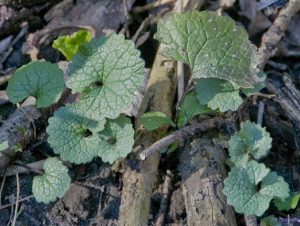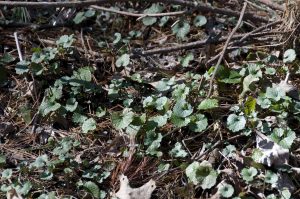Ready, Set, Spray

This week is your chance to Roundup garlic mustard before spring wildflowers start to appear. This invasive plant from Europe forms dense mats in woodlands and along edges that poison the soil crowd out spring wildflowers.
Early spring is a great time of year to get ahead of this serious invasive pest. Plants are small and more easily killed by herbicide. Native plants are still dormant and will be for a couple more weeks.
Roundup (glyphosate) is a non-selective herbicide which means that any plant that gets sprayed will die or be seriously injured. It breaks down in sunlight and the soil within two weeks. This means spring wildflowers that sprout in late April and early may will not be hurt.
To be fully effective, glyphosate must spend enough time on the leaves to be absorbed. Make sure that leaves are dry and that there is no rain forecast for twelve hours after spraying. This gives the herbicide time to get transported from the leaves down into the roots where it does kills the plant.
Follow label directions, typically a 3-5% solution depending the formulation of glyphosate. In this case more is not better; it simply wastes money. Leaves will only absorb so much and the rest breaks down in the soil as the plant dies. Likewise, only spray leaves to the point of runoff; again the rest is wasted money.
As always, there may be some desirable plants nearby that have already sprouted or are likely to appear in the coming days, so only spray areas where garlic mustard is actively growing.
New garlic mustard plants may sprout later in the season, but since it is a biennial they will not bloom or set seed until next year.
My favorite method to control garlic mustard is with prescribed fire. Not only does it kill the weeds and their seed in the soil, it stimulates fire adapted native plant seeds to germinate. Unfortunately, you must have a trained and well equipped which most private landowners find too difficult to find or expensive to afford. Garlic mustard also often grows in areas that lack enough ground fuel to carry fire through the weed patches.

Head to the Wisconsin DNR website for more information about controlling garlic mustard.
